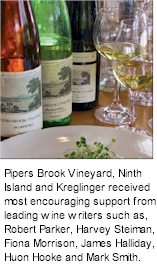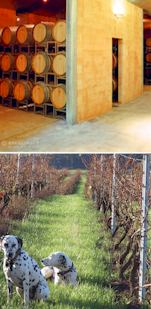


Pipers Brook Estate is a small winery where all it's wines are estate-grown and bottled. The winery produces over ten varieties of red, white and sparkling wines under the Pipers Brook Vineyard , Pirie and Ninth Island labels. Pipers Brook Vineyard grapes are sourced entirely from within the Tasmanian appellation. Its wines are available in seventeen countries.

Pipers Brook Vineyard is strongly vertically integrated with an acquired depth of skills in site selection, vineyard development and management, winemaking, bottling and marketing. Pipers Brook Estate's vineyards are distributed around the north coast of Tasmania, on the western banks of the scenic Tamar River slightly north of Launceston, as well as within the Pipers Brook and Pipers River regions.
Climatically each vineyard site is different from the next. Its the subtle differences in climatic conditions between sites and between vines that becomes part of the complex answer to the production of cool climate wines of the highest quality for which the winemakers strive to produce. Vineyards along the banks of the Tamar river are located inland, slightly less exposed to the prevailing NW winds blowing off Bass Straight which create temperature cooling effects.
As a consequence grapes generally mature some 10 days earlier with slightly higher yields from the Tamar river vineyards. This increases ripening potential and creates a useful spread of harvesting and processing times. These vineyards provide quality and quantity as well as being ideally suited to the production of later ripening varieties such as Riesling and Sauvignon Blanc.

The cooler climatic conditions experienced by the more coastal Pipers Brook and Pipers River regions create a perfect environment for the production of sparkling wines due to the fruits retention of naturally high acidity, lower sugar accumulation yet early flavour ripeness. Let the fruit hang on the vines a little longer and the premium table wine production of Pinot Noir, Pinot Gris, Chardonnay and Riesling begins.
Vines like deep porous soils and the best wines are produced where a deep-rooted vine is neither under or over supplied with moisture. Pipers Brook Vineyard have selected the ferrosol or kraznozems of northern Tasmania for their best vineyards because the soils are deep, well drained and with ideal moisture characteristics. Although the red colour makes them look rich, in their native state they are quite poor being quite deficient in phosphorous, zinc and boron.
The red soils at Pipers Brook vineyard are classed as kraznozems; they are deep and friable soils derived from volcanic parent and share some physical characteristics with terra rossa soils. Wine exhibits the 'gout de terroir' or specific taste of the site when they exhibit a repeatable character unique to the region and even vineyard.
Tasmanian wines are unique. The sparkling wines, rieslings, pinot noirs, sauvignon blancs, chardonnays are developing a character which is individual to the region. Pipers Brook Vineyard produce genuine expressions of the Tasmanian wine character based on the impact of the terroir. The strength of their commitment is such as to include this word in the vision statement.
